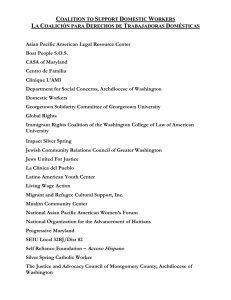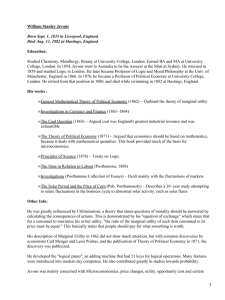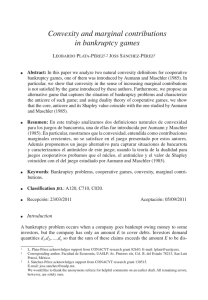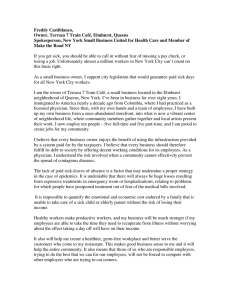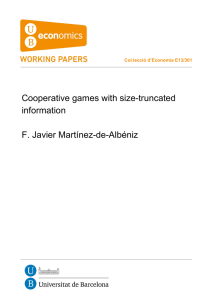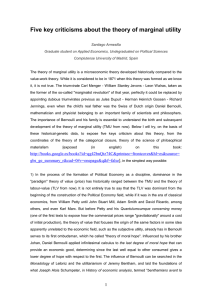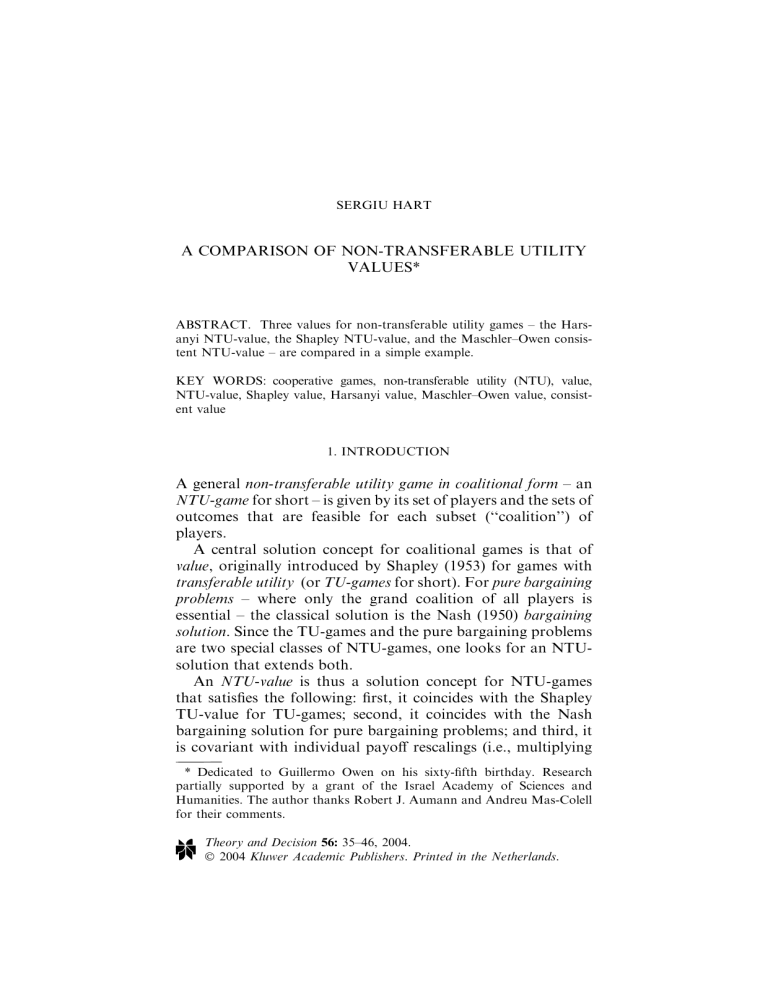
SERGIU HART A COMPARISON OF NON-TRANSFERABLE UTILITY VALUES* ABSTRACT. Three values for non-transferable utility games – the Harsanyi NTU-value, the Shapley NTU-value, and the Maschler–Owen consistent NTU-value – are compared in a simple example. KEY WORDS: cooperative games, non-transferable utility (NTU), value, NTU-value, Shapley value, Harsanyi value, Maschler–Owen value, consistent value 1. INTRODUCTION A general non-transferable utility game in coalitional form – an NTU-game for short – is given by its set of players and the sets of outcomes that are feasible for each subset (‘‘coalition’’) of players. A central solution concept for coalitional games is that of value, originally introduced by Shapley (1953) for games with transferable utility (or TU-games for short). For pure bargaining problems – where only the grand coalition of all players is essential – the classical solution is the Nash (1950) bargaining solution. Since the TU-games and the pure bargaining problems are two special classes of NTU-games, one looks for an NTUsolution that extends both. An NTU-value is thus a solution concept for NTU-games that satisfies the following: first, it coincides with the Shapley TU-value for TU-games; second, it coincides with the Nash bargaining solution for pure bargaining problems; and third, it is covariant with individual payoff rescalings (i.e., multiplying * Dedicated to Guillermo Owen on his sixty-fifth birthday. Research partially supported by a grant of the Israel Academy of Sciences and Humanities. The author thanks Robert J. Aumann and Andreu Mas-Colell for their comments. Theory and Decision 56: 35–46, 2004. 2004 Kluwer Academic Publishers. Printed in the Netherlands. 36 SERGIU HART the payoffs of a player by a factor a > 0 multiplies his value payoffs by the same factor a). The above three requirements do not however determine the NTU-value uniquely. Indeed, different NTU-values have been proposed in the literature; the most notable are due to Harsanyi (1963), Shapley (1969), and Maschler and Owen (1992).1 In this short note we analyze in detail a simple example of an NTU-game where the three values yield different outcomes. It is essentially the simplest possible example: there are just three players (a two-player game is a pure bargaining problem), and the coalitional function corresponds to a TU-game except for one coalition, for which the transfers of utility are possible albeit at a rate different from 1. The difference between the values will be seen to be due to the way that subcoalitions are handled.2 It is to be hoped that the analysis here will shed further light on the NTU-values, their meanings and interpretations. The reader is referred to the chapters on value in the Handbook of Game Theory, in particular McLean (2002), for further material and references. The game is defined in Section 2; the values are computed in Sections 3–5, and compared in Section 6. Sections 7 and 8 present an exchange economy (a ‘‘market’’) and a ‘‘prize game’’ (see Hart (1994)) that generate our example. Some notations: R is the real line; for a finite set S, the number of elements of S is denoted jSj; the jSj-dimensional Euclidean space with coordinates indexed by S (or, equivalently, the set of real functions on S) is RS ; the nonnegative orthant of RS is RSþ ; and A B denotes weak inclusion (i.e., possibly A ¼ B). 2. THE EXAMPLE A non-transferable utility game in coalitional form is a pair ðN; VÞ, where N – the set of players – is a finite set, and V – the coalitional function – is a mapping that associates to each coalition S N the set VðSÞ RS of feasible payoff vectors for S. An element x ¼ ðxi Þi2S of VðSÞ is interpreted as follows: there exists an outcome that is feasible for the coalition S whose A COMPARISON OF NON-TRANSFERABLE UTILITY VALUES 37 utility to player i is xi (for each i in S). Thus VðSÞ is the set of utility combinations that are feasible for the coalition S. The standard assumptions are that for each nonempty coalition S, the set VðSÞ is a nonempty strict subset of RS that is closed, convex, and comprehensive (y x 2 VðSÞ implies y 2 VðSÞ). A game ðN; VÞ is a transferable utility game (or TU-game for short) if for each coalition P S there exists a real number vðSÞ such that VðSÞ ¼ fx 2 RS : i2S xi vðSÞg. This game is denoted ðN; VÞ or ðN; vÞ interchangeably, and the function v is called the worth function. Our example is the NTU-game ðN; VÞ with three players N ¼ f1; 2; 3g and coalitional function3 VðiÞ ¼ fxi : xi 0g for i ¼ 1; 2; 3; Vð12Þ ¼ fðx1 ; x2 Þ : x1 þ x2 36; x1 þ 2x2 36g; Vð13Þ ¼ fðx1 ; x3 Þ : x1 þ x3 0g; Vð23Þ ¼ fðx2 ; x3 Þ : x2 þ x3 0g; Vð123Þ ¼ fðx1 ; x2 ; x3 Þ : x1 þ x2 þ x3 36g: Except for coalition f1; 2g – whose feasible set V(12) is depicted in Figure 1 – our game ðN; VÞ coincides with a TU-game, which we denote by ðN; wÞ or ðN; WÞ. Thus w is the worth function 36; for S ¼ f1; 2g; f1; 2; 3g, wðSÞ ¼ ð1Þ 0; otherwise, P and WðSÞ ¼ fx 2 RS : i2S xi wðSÞg for all S. The game ðN; VÞ is 0-normalized (single players get 0) and monotonic (if S T and x 2 VðSÞ then4 (x; 0T nS Þ 2 VðTÞ). The (Pareto efficient) boundary of VðNÞ, which is denoted oVðNÞ, is a hyperplane with slope k ¼ ð1; 1; 1Þ. This example is not new; a similar one appears in Owen (1972) (see also Hart and Mas-Colell (1996, p. 369)). 3. THE SHAPLEY NTU-VALUE The Shapley NTU-value for a general NTU-game ðN; VÞ is obtained by the following procedure: 38 SERGIU HART Figure 1. The feasible set for coalition f1; 2g: • For each weight vector k 2 RN þ ; k 6¼ 0: 1. Let the payoff vector z 2 RN satisfy ki zi ¼ uiTU ðN; vk Þ for all i 2 N; where the TU-game ðN; vk Þ is obtained from ðN; VÞ by allowing of utilities at the rates k, i.e., vk ðSÞ ¼ P transfers i i i supf i2S k x : ðx Þi2S 2 VðSÞg for all5 S N, and uTU is the Shapley TU-value. 2. If z is feasible for the grand coalition, i.e., if z 2 VðNÞ, then z is a Shapley NTU-value of ðN; VÞ. For our game ðN; VÞ only k ¼ ð1; 1; 1Þ needs to be considered (any k that is not a multiple of ð1; 1; 1Þ yields vk ðNÞ ¼ 1), in which case vk w (see (1)). The Shapley TU-value rS of each subgame6 ðS; wÞ is easily computed: rfig ¼ 0 for singletons, and rf1;2g ¼ ð18; 18Þ, rf1;3g ¼ ð0; 0Þ, and rf2;3g ¼ ð0; 0Þ for the twoplayer subgames. It will be convenient to write rS as a threedimensional vector with ‘‘–’’ for the players outside S: rf1;2g ¼ ð18; 18; Þ; rf1;3g ¼ ð0; ; 0Þ; rf2;3g ¼ ð; 0; 0Þ: Next, for each two-player coalition S we adjoin to rS a payoff for the missing player (in boldface below) so that the A COMPARISON OF NON-TRANSFERABLE UTILITY VALUES 39 ^S is efficient for N (i.e., the coordinates resulting payoff vector r add up to 36): ^f1;2g ¼ ð18; 18; 0Þ; r ^f1;3g ¼ ð0; 36; 0Þ; r ^f2;3g ¼ ð36; 0; 0Þ: r We then average these three vectors to obtain the value for N: rN ¼ ð18; 18; 0Þ: Indeed, the Shapley TU-value of a player i in a TU-game ðN; vÞ is the average of his marginal contribution to the grand coalition vðNÞ vðNniÞ, and his values in the subgames with jNj 1 players: 2 3 X 1 4 vðNÞ vðNniÞ þ uiTU ðNnj;vÞ5; uiTU ðN; vÞ ¼ ð2Þ jNj j2Nni see Hart and Mas-Colell (1996, p. 369). The above payoff vector rN is thus the unique Shapley NTUvalue of our game ðN; VÞ. 4. THE HARSANYI NTU-VALUE The Harsanyi NTU-value for a general NTU-game ðN; VÞ is obtained by the following procedure: • For each weight vector k 2 RN þ ; k 6¼ 0: 1. Let the payoff vector z 2 oVðNÞ be the k-egalitarian solution of the game ðN; VÞ. 2. If k is a supporting normal to the boundary of VðNÞ at z (i.e., if z is also k-utilitarian) then z is a Harsanyi NTUvalue of ðN; VÞ. The k-egalitarian solution is constructed recursively: for each S, given the payoff vectors gT 2 VðTÞ for all strict subsets T of S, the payoff vector gS is determined by gS 2 oVðSÞ and ki ðgiS giSnj Þ ¼ kj ðgjS gjSni Þ for all i; j 2 S: ð3Þ 40 SERGIU HART The k-egalitarian solution z is the resulting payoff vector gN for the grand coalition. For our game ðN; VÞ we need to consider only k ¼ ð1; 1; 1Þ. This yields gfig ¼ 0 for all i, and gf1;2g ¼ ð12; 12; Þ; gf1;3g ¼ ð0; ; 0Þ; gf2;3g ¼ ð; 0; 0Þ: Indeed, for each two-player coalition fi; jg the egalitarian solution is the payoff vector x 2 oVðijÞ with equal coordinates (i.e., xi ¼ xj ). For the grand coalition N we use the same construction as for the Shapley TU-value. First, we extend each gS to a payoff vector ^ gS that is efficient for N: ^ gf1;2g ¼ ð12; 12; 12Þ; ^ gf1;3g ¼ ð0; 36; 0Þ; ^ gf2;3g ¼ ð36; 0; 0Þ; and then we average the three vectors to yield gN : gN ¼ ð16; 16; 4Þ: This construction is correct since the egalitarian solution of ðN; VÞ is the Shapley TU-value of the game ðN; uÞ with uðSÞ ¼ Ri2S giS for all S N; see Hart (1985, (4.6)). Thus gN is the egalitarian solution for N, and therefore the unique Harsanyi NTU-value of ðN; VÞ; in terms of Hart (1985), the collection (gS ÞSN we have obtained is the Harsanyi payoff configuration. 5. THE MASCHLER–OWEN CONSISTENT NTU-VALUE The Maschler–Owen consistent NTU-value for a general NTUgame ðN; VÞ is obtained recursively by the following procedure: Let S be a coalition, and assume that a payoff vector cT 2 VðTÞ is given for all strict subcoalitions T of S. For each weight vector k 2 RSþ ; k 6¼ 0: A COMPARISON OF NON-TRANSFERABLE UTILITY VALUES 41 1. Let the payoff vector z 2 RS satisfy 2 3 X X 1 ki zi ¼ 4vk ðSÞ kj cjSni þ ki ciSnj 5 for all i 2 S; jSj j2Sni j2Sni ð4Þ P where, again, vk ðSÞ ¼ supf i2S ki xi : ðxi Þi2S 2 VðSÞg. 2. If z is feasible for the coalition S, i.e., if z 2 VðSÞ, then define cS ¼ z. The resulting payoff vector cN for the grand coalition is then a Maschler–Owen consistent NTU-value of ðN; VÞ. Formula (4) – which is a generalization of (2) in the TU-case – is equivalent to7 X ki zi ¼ vk ðSÞ and i2S X ki ðzi ciSnj Þ ¼ j2Sni X j kj ðzj cSni Þ for all i 2 S; j2Sni see Proposition 4 and Formula (3) in Hart and Mas-Colell (1996), and Formula (5.1) in Maschler and Owen (1989). For our game ðN; VÞ we have cfig ¼ 0 for all i, and cf1;2g ¼ ð18; 9; Þ; cf1;3g ¼ ð0; ; 0Þ; cf2;3g ¼ ð; 0; 0Þ: Indeed, for two players, the consistent value coincides with the Nash bargaining solution. Now (4) allows us to use again the ‘‘extension’’ construction (k ¼ ð1; 1; 1Þ): ^cf1;2g ¼ ð18; 9; 9Þ; ^cf1;3g ¼ ð0; 36; 0Þ; ^cf2;3g ¼ ð36; 0; 0Þ; and their average is cN ¼ ð18; 15; 3Þ: 42 SERGIU HART Therefore cN is the unique Maschler–Owen consistent NTUvalue of ðN; VÞ. 6. A COMPARISON To recapitulate, the three NTU-values of our game ðN; VÞ are uSh ðN; VÞ ¼ ð18; 18; 0Þ; uHa ðN; VÞ ¼ ð16; 16; 4Þ; ð5Þ uMO ðN; VÞ ¼ ð18; 15; 3Þ: The computations leading to these values clearly exhibit that the difference between them derives from the way the intermediate payoff vector xf1;2g for the coalition f1; 2g – the only coalition whose feasible set is not of the TU-type – is determined. Indeed, the payoff vectors xS for all other strict subsets of N are identical for the three values, and, once all the xS are given, the value for the grand coalition xN is uniquely determined (by the ‘‘extension’’ construction with respect to k ¼ ð1; 1; 1Þ, the unique supporting normal to oVðNÞ). The payoff vectors xf1;2g for the coalition f1; 2g are, respectively, xSh f1;2g ¼ ð18; 18Þ; xHa f1;2g ¼ ð12; 12Þ; xMO f1;2g ¼ ð18; 9Þ; (see Figure 2). The Shapley NTU-value and the Harsanyi NTU-value both take xf1;2g to be an egalitarian outcome (i.e., an ‘‘equal-split’’ payoff vector – since the rates of interpersonal utility comparison k dictated by the grand coalition satisfy k1 ¼ k2 ). The difference is that the Harsanyi approach uses Vð12Þ, the feasible set for f1; 2g, to determine xf1;2g ; whereas the Shapley approach allows transfers of utility at the rates k of the grand coalition and so V(12) is replaced by W(12) (which corresponds to vk (12)). Thus xHa f1;2g ¼ ð12; 12Þ 2 oVð12Þ and Sh xf1;2g ¼ ð18; 18Þ 2 oWð12Þ. As for the Maschler–Owen NTUvalue, it considers coalition f1; 2g independently of the grand A COMPARISON OF NON-TRANSFERABLE UTILITY VALUES 43 Figure 2. The intermediate payoff vectors for coalition f1; 2g. coalition: xf1;2g is determined by the f1; 2g-subgame only. Moreover, xf1;2g is determined for f1; 2g in exactly the same way that xN is determined for N; this property – that xS is the consistent NTU-value of the S-subgame for each S – is called ‘‘subcoalition perfectness’’ in Hart and Mas-Colell (1996, p. 366). Thus xMO f1;2g ¼ ð18; 9Þ, the Nash bargaining solution of the two-person game. Which approach is ‘‘correct’’? There cannot be a definite answer.8 For instance, it may depend on the way the interactions between the players are conducted.9 If transfers are allowed (or ‘‘implied’’ by the grand coalition10 ) as in the Shapley NTU-value, then player 3 becomes a null (‘‘dummy’’) player, and his value of 0 is justified. Otherwise player 3 is not a null player, and his value is positive. The Harsanyi NTU-value is egalitarian-based; therefore players 1 and 2 get equal payoffs. In contrast, the Maschler–Owen NTU-value takes into account the asymmetry between the two players in the subcoalition f1; 2g – and is the only one to do so. Thus it appears that the Maschler–Owen consistent NTU-value reflects the structure of this game better than the other NTU-values.11 44 SERGIU HART 7. AN EXCHANGE ECONOMY Our example is essentially a market game.12 For instance, take E to be the following exchange economy (‘‘market’’): there are three players (‘‘traders’’) i ¼ 1; 2; 3, and three commodities; the utility functions are u1 ða1 ; a2 ; a3 Þ ¼ 36a1 þ 36a2 36; u2 ða1 ; a2 ; a3 Þ ¼ 18a1 þ 36a3 ; u3 ða1 ; a2 ; a3 Þ ¼ 36a1 þ 36a3 36 (aj denotes the quantity of good j), and the initial commodity bundles (‘‘endowments’’) are e1 ¼ ð1; 0; 0Þ; e2 ¼ ð0; 1; 0Þ; e3 ¼ ð0; 0; 1Þ: Let (N; VE ) be the resulting NTU-market game; i.e., V ðSÞ ¼ fx 2 RS : there exists an S-allocation (ci Þi2S with Ri2S ci ¼ Ri2S ei ; ci 2 R3þ and xi ui ðci Þ for all i 2 Sg for all S N ¼ f1; 2; 3g. The individually rational payoff vectors of (N; VE ) coincide with those of our example ðN; VÞ; i.e., for all S N we have VE ðSÞ \ RSþ ¼ VðSÞ \ RSþ (note that ui ðei Þ ¼ 0 and oVðiÞ ¼ f0g for all i), and also VE ðSÞ VðSÞ. This implies that the NTU-values of ðN; VÞ given in (5) are also NTU-values for (N; VE ). One can check that (N; VE ) has no other values.13 E 8. A PRIZE GAME Our example is also essentially a hyperplane game, and it can thus be represented as a prize game; see Hart (1994). Indeed, let the prize of the grand coalition be worth 36 to each player, and let the prize of coalition f1; 2g be worth 36 to player 1 and 18 to player 2 (there are no other prizes). The resulting game (N; V ) is again identical to our example ðN; VÞ in the individually rational region, and its NTU-values are given by (5). A COMPARISON OF NON-TRANSFERABLE UTILITY VALUES 45 NOTES 1. The Shapley NTU-value is sometimes referred to as the ‘k-transfer value,’ and the Maschler–Owen value is called the ‘consistent NTU-value.’ Axiomatizations of these values have been provided by Aumann (1985) for the Shapley NTU-value, by Hart (1985) for the Harsanyi NTUvalue, by de Clippel, Peters and Zank (2002) and Hart (1994, 2003) for the Maschler–Owen NTU-value. Another NTU-value was proposed by Owen (1972). 2. See also the discussions in Hart (1985, Section 5), Hart and Mas-Colell (1996, Section 4), and de Clippel et al. (2002, Section 4). 3. For simplicity we write V(1), V(12), . . . instead of the more cumbersome Vðf1gÞ, Vðf1; 2gÞ; . . .; similarly, Sni for Snfig, and so on. 4. 0TnS is the 0-vector in RT nS . 5. If the ‘sup’ in the definition vk ðSÞ is infinite for some S then there is no NTU-value corresponding to this k (and the procedure for this k stops here). 6. The ‘subgame’ (S; V) of ðN; VÞ is obtained by restricting the domain of V to the subsets of S. 7. Compare (3). 8. For a general discussion of the multiplicity of solution concepts, see ‘1930–1950, Section iii’ in Aumann (1987). 9. Different NTU-values may be thought of, inter alia, as corresponding to different bargaining procedures – from which the coalitional form abstracts away. For example, the noncooperative model of Hart and MasColell (1996) leads to the Maschler–Owen NTU-value (and thus, a fortiori, to the Shapley TU-value and the Nash bargaining solution). It would be of interest to obtain explicit bargaining procedures leading to other NTU-values. 10. See Myerson (1991, pp. 475–476). 11. To emphasize the differences between the values, consider the case where V(12) becomes more and more ‘‘flat’’: replace x1 þ 2x2 36 with x1 þ mx2 36; and let m ! 1. Then uSh ¼ ð18; 18; 0Þ; uHa ! ð12; 12; 12Þ; and uMO ! ð18; 12; 6Þ: 12. I.e., it coincides with a market game in the relevant (individually rational) region; see below. 13. Since k ¼ ð1; 1; 1Þ is no longer the unique supporting normal to the boundary of VE ðNÞ, one needs to consider additional weight vectors k (including zero weights). We omit the straightforward but lengthy arguments that show that no other values are obtained. 46 SERGIU HART REFERENCES Aumann, R.J. (1985), An axiomatization of the non-transferable utility value, Econometrica 53, 599–612. Aumann, R.J. (1987), Game theory, in J. Eatwell, M. Milgate, and P. Newman (eds), The New Palgrave: A Dictionary of Economics, Vol. 2, London: Macmillan, 460–482. De Clippel, G., Peters, H. and Zank, H. (2002), Axiomatizing the Harsanyi Solution, the Symmetric Egalitarian Solution, and the Consistent Shapley Solution for NTU-Games, mimeo. Harsanyi, J.C. (1963), A simplified bargaining model for the n-person cooperative game, International Economic Review 4, 194–220. Hart, S. (1985), An axiomatization of Harsanyi’s non-transferable utility solution, Econometrica 53, 1295–1313. Hart, S. (1994), On prize games, in N. Megiddo (ed.), Essays in Game Theory, Berlin: Springer-Verlag, 111–121. Hart, S. (2003), An Axiomatization of the Consistent Non-Transferable Utility Value, Center for Rationality DP-337, The Hebrew University of Jerusalem, mimeo. Hart, S. and Mas-Colell, A. (1996), Bargaining and value, Econometrica 64, 357–380. Maschler, M. and Owen, G. (1989), The consistent Shapley value for hyperplane games, International Journal of Game Theory 18, 389–407. Maschler, M. and Owen, G. (1992), The consistent Shapley value for games without side payments, in R. Selten (ed.), Rational Interaction, New York: Springer-Verlag, 5–12. McLean, R. (2002), Values of non-transferable utility games, in R.J. Aumann and S. Hart (eds), Handbook of Game Theory, with Economic Applications, Vol. 3, Amsterdam: Elsevier, 2077–2120. Myerson, R.B. (1991), Game Theory, Cambridge MA: Harvard University Press. Nash, J. (1950), The bargaining problem, Econometrica 18, 155–162. Owen, G. (1972), A value for games without side payments, International Journal of Game Theory 1, 95–109. Shapley, L.S. (1953), A value for n-person games, in H.W. Kuhn and A.W. Tucker (eds), Contributions to the Theory of Games II, Annals of Mathematics Studies 28, Princeton: Princeton University Press, 307–317. Shapley, L.S. (1969), Utility comparison and the theory of games, in La De´cision, Paris: Editions du CNRS, 251–263. Address for correspondence: Sergiu Hart, Center for Rationality and Interactive Decision Theory, Department of Mathematics, and Department of Economics, The Hebrew University of Jerusalem, Feldman Building, Givat Ram, 91904 Jerusalem, Israel (E-mail: [email protected]; URL: http://www.ma.huji.ac.il/hart)
